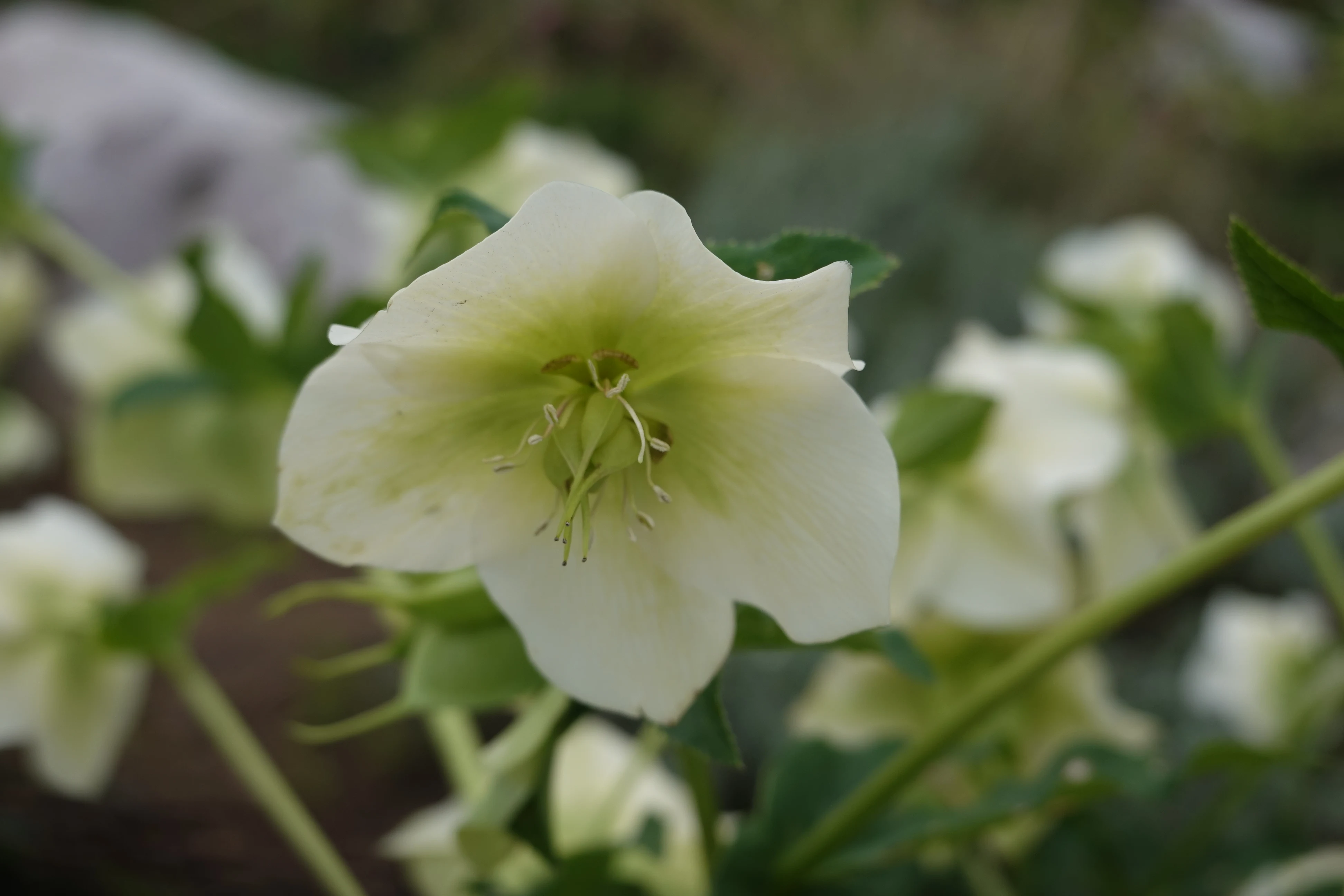These hellebore flowers are seen at the main entrance to the Huntington Library. Hellebores consists of approximately 20 species of herbaceous or evergreen perennial flowering plants in the family Ranunculaceae. Despite common names such as winter rose, Christmas rose, and Lenten rose, hellebores are not closely related to the rose family (Rosaceae). The flowers have five petal-like sepals surrounding a ring of small, cup-like nectaries which are actually petals modified to hold nectar. The sepals do not fall as petals would, but remain on the plant, sometimes for many months. The persistence of the sepals may contribute to the development of the seeds. All helleborus plants are toxic, and all parts of the helleborus plant are toxic. Poisonings occur through ingestion or handling. Hellebore plants should not be ingested as poisoning cases are most severe when the plants are eaten. Dermatitis may also occur from handling the hellebore plants without protection. Despite its toxicity, "black hellebore" was used by the Greeks and Romans to treat paralysis, gout and other diseases, more particularly insanity.
這些鐵筷子花是在亨廷頓圖書館的大門口進口處看到的。鐵筷子屬/嚏根草屬包括毛茛科的約 20 種草本或常綠多年生開花植物。雖然鐵筷子有冬玫瑰、聖誕玫瑰和四旬玫瑰等俗名,但它與薔薇科植物並沒有密切的關係。花朵有五個花瓣狀的萼片,環繞著一圈小的杯狀蜜腺,這些蜜腺實際上是經過改造以容納花蜜的花瓣。萼片不會像花瓣那樣掉落,而是留在植物上,有時長達數月。萼片的持久存在可能有助於種子的發育。








Notes 筆記
- Hellebores consists of approximately 20 species of herbaceous or evergreen perennial flowering plants in the family Ranunculaceae. Despite common names such as winter rose, Christmas rose, and Lenten rose, hellebores are not closely related to the rose family (Rosaceae).
- The scientific name Helleborus could derive from the Ancient Greek word ἑλλέβορος (helléboros). It is also possibly from Greek, ἄλκη “fawn”, βιβρώσκω (bibrṓskō, “to eat”).
- The flowers have five petal-like sepals surrounding a ring of small, cup-like nectaries which are actually petals modified to hold nectar. The sepals do not fall as petals would, but remain on the plant, sometimes for many months. The persistence of the sepals may contribute to the development of the seeds.[
- Various species of this genus originated in Europe and Asia. The greatest concentration of species occurs in the Balkans. One atypical species (H. thibetanus) comes from western China; another atypical species (H. vesicarius) inhabits a small area on the border between Turkey and Syria.
- The so-called Christmas rose (H. niger), a traditional cottage garden favourite, bears its pure white flowers (which often age to pink) in the depths of winter. The most popular hellebores for garden use are H. orientalis and its colourful hybrids, H. × hybridus (Lenten rose).
- All helleborus plants are toxic, and all parts of the helleborus plant are toxic. Poisonings occur through ingestion or handling. Hellebore plants should not be ingested as poisoning cases are most severe when the plants are eaten. Dermatitis may also occur from handling the hellebore plants without protection. Despite its toxicity, "black hellebore" was used by the Greeks and Romans to treat paralysis, gout and other diseases, more particularly insanity.
- H. niger is commonly called the Christmas rose, due to an old legend that it sprouted in the snow from the tears of a young girl who had no gift to give the Christ Child in Bethlehem.
- In Greek mythology, Melampus of Pylos used hellebore to save the daughters of the king of Argos from a madness, induced by Dionysus, that caused them to run naked through the city, crying, weeping, and screaming.
- During the Siege of Kirrha in 585 BC, hellebore was reportedly used by the Greek besiegers to poison the city's water supply. The defenders were subsequently so weakened by diarrhea that they were unable to defend the city from assault.
- In a fit of madness induced by Hera, Heracles killed his children by Megara. His madness was cured using hellebore.
- 鐵筷子屬/嚏根草屬包括毛茛科的約 20 種草本或常綠多年生開花植物。雖然嚏根草有冬玫瑰、聖誕玫瑰和四旬玫瑰等俗名,但它與薔薇科植物並沒有密切的關係。
- 鐵筷子的學名可能源自古希臘語單字 ἑλλέβορος (helléboros)。它也可能來自希臘語,ἄλκη“小鹿”,βιβρώσκω(bibrṓskō,“吃”)。
- 花朵有五個花瓣狀的萼片,環繞著一圈小的杯狀蜜腺,這些蜜腺實際上是經過改造以容納花蜜的花瓣。萼片不會像花瓣那樣掉落,而是留在植物上,有時長達數月。萼片的持久存在可能有助於種子的發育。
- 該屬的各種物種起源於歐洲和亞洲。這些物種最集中的地方是巴爾幹半島。有一個非典型種(H. thibetanus)來自中國西部;另一個非典型物種(H. vesicarius)來在土耳其和敘利亞邊境的一小片區域。
- 所謂的聖誕玫瑰(H. niger)是傳統村舍花園的寵兒,在隆冬時節開出純白色的花朵(通常會變成粉紅色)。最受歡迎的用於園林的嚏根草是 H. orientalis 及其色彩鮮豔的雜交品種 H. × hybridus (Lenten rose)。
- 所有鐵筷子植物都有毒,嚏根草植物的所有部分也都有毒。中毒是由於攝入或處理而發生的。嚏根草植物不應被食用,因為食用後中毒情況最為嚴重。在沒有防護的情況下接觸嚏根草植物也可能會引發皮膚炎。儘管具有毒性,「黑鐵筷子」還是被希臘人和羅馬人用來治療癱瘓、痛風和其他疾病,尤其是精神錯亂。
- H. niger 通常被稱為聖誕玫瑰,源自於一個古老的傳說,說它是在雪中從一位沒有禮物送給伯利恆聖嬰的小女孩的眼淚中發芽的。
- 在希臘神話中,皮洛斯的墨蘭普斯用嚏根草拯救了阿爾戈斯國王的女兒們,她們因狄俄尼索斯而發瘋,導致她們赤裸裸地穿過城市,哭泣、尖叫。
- 據報道西元前 585 年基拉圍城戰期間,希臘圍城者使用嚏根草來毒害城市的水源。守軍隨後因腹瀉而變得十分虛弱,以至於他們無法保衛城市免受攻擊。
- 赫拉克勒斯在赫拉的煽動下陷入瘋狂,殺死了他和墨伽拉所生的孩子。他的瘋狂症狀透過嚏根草得到治癒。
References 參考資料
Plants Posts 植物的帖子
Comments